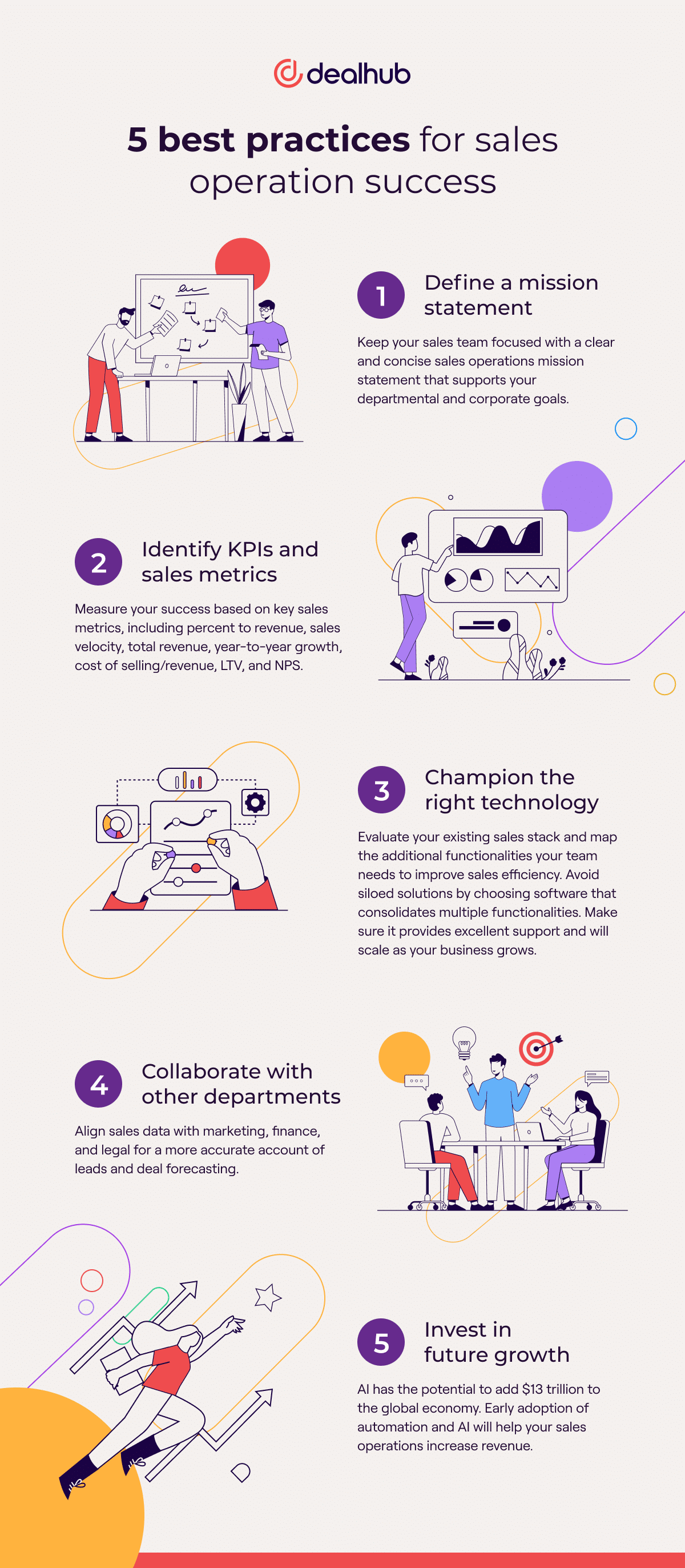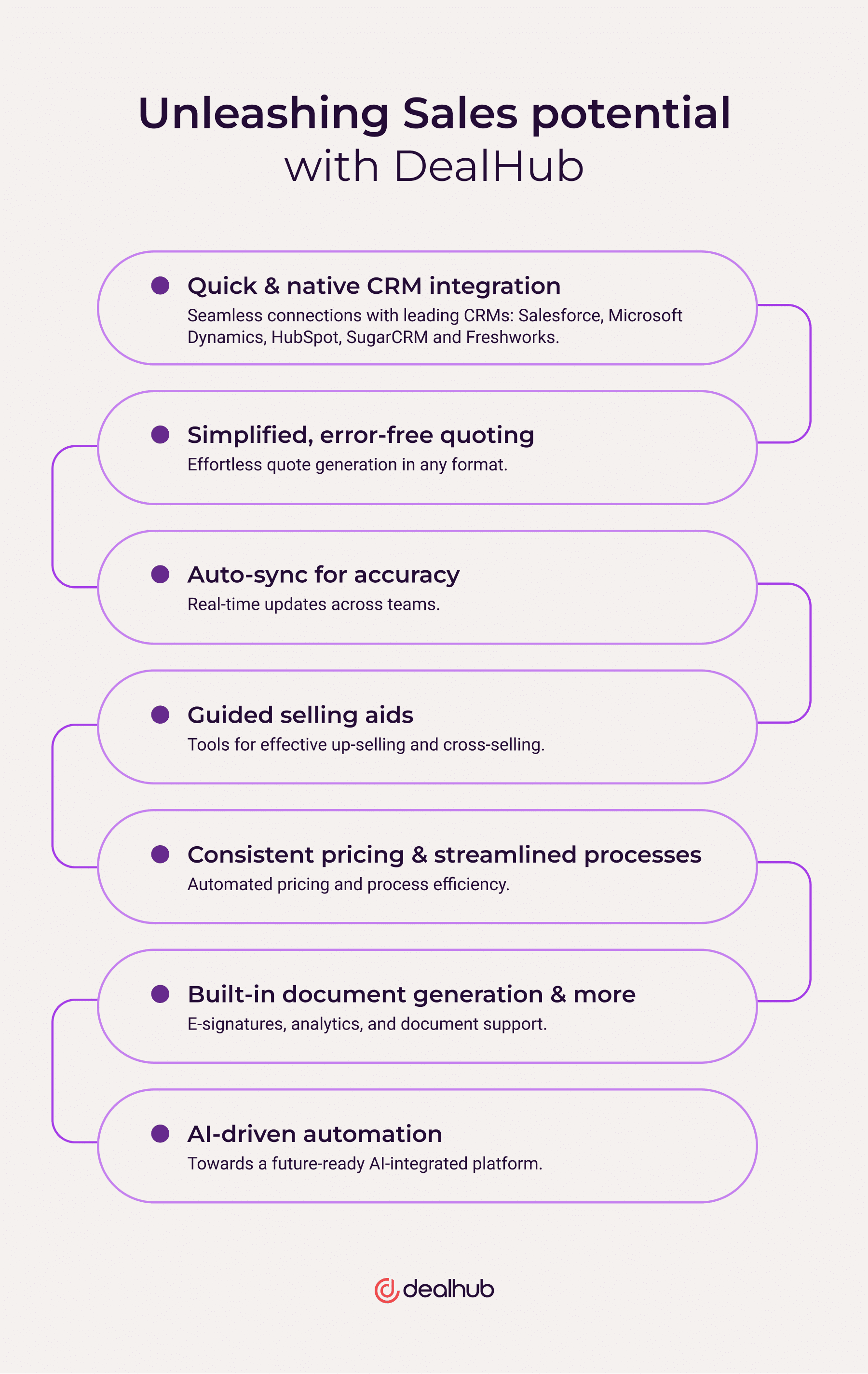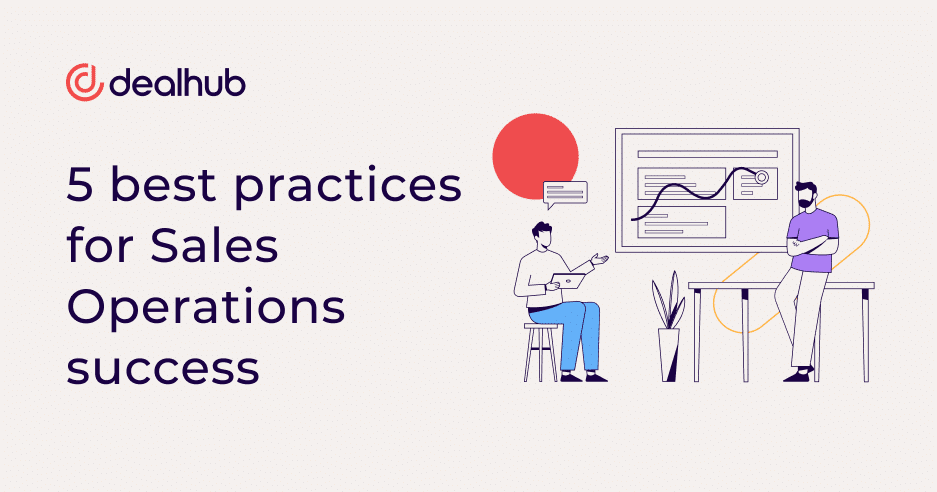As an organization, hitting those revenue goals is crucial, and the backbone of achieving this lies in a well-oiled sales operations machine. So, let’s roll up our sleeves and explore some critical best practices for sales that will set you on the path to sales operations success.
The role of Sales Operations (Sales Ops) in the sales process
Take a moment to imagine a well-choreographed dance routine. Each step must be perfectly timed, with every movement synchronized across different people. Best practices in sales operations act like a choreographer for your sales process. They are the backbone that keeps everything in harmony to maintain a flawless delivery structure. From strategy to execution, sales operations are the behind-the-scenes magic that streamlines workflows, removes obstacles, and empowers your sales team.
Sales technology management
Modern businesses need to have the right tools at their fingertips. This can make the difference between making that sale or losing a client. Sales technology management involves selecting, implementing, and optimizing the sales tools and platforms that empower your team to work smarter instead of harder. A well-curated tech stack that combines customer relationship management (CRM) systems, communication tools, and analytics software can boost productivity and enhance customer experiences, giving you a competitive edge.
Sales data analysis
Numbers never lie, and sales data analysis is the secret weapon. With proper analysis, teams can reveal insights and make data-driven decisions. By diving deep into the data, businesses can identify patterns, understand customer behaviors, and spot areas for improvement. When sales teams are armed with tangible, traceable insights, it’s easier to fine-tune strategies, optimize a sales approach, and tailor messaging to better resonate with a target audience. In short, data analysis gives you the power to turn information into action.
Sales forecasting
What would you do if you had unfettered access to a crystal ball that could reveal future sales numbers? Sales forecasting gets pretty close to having a psychic in your back pocket. Future sales are predictable with reasonable accuracy when companies invest in analyzing historical data, trends, and other market variables. These valuable insights enable a company to allocate resources effectively, adjust strategy, pivot if needed, and stay ahead of the curve. Sales forecasting is your North Star, whether you’re planning your inventory, setting realistic targets, or making crucial business decisions.
Analyzing and improving the sales process
Regularly analyzing and improving sales processes cannot be stressed enough. Sales are dynamic, and success isn’t a destination but a journey of continuous improvement. By identifying pain points, bottlenecks, and areas of inefficiency, companies can optimize best practices for sales processes to ensure a smooth and delightful customer experience. The willingness to embrace change, fine-tune, experiment with new approaches, and be forward-thinking ensures you are always ahead of the competition.
Sales team training and development
Behind every successful sales operation is a motivated, well-trained sales team. Investing in the professional development and training of your salespeople is an investment in the company writ large. Equip your team with the insights, knowledge, skills, and tools to wow clients and hit targets. It’s essential to foster a culture of continuous learning, including coaching and mentoring opportunities. Sales teams should also be collaborative, and not competitive. A well-trained team that feels supported is not only more effective in closing deals, but they are also happier and more engaged in their work.
Supporting sales pipeline management
The sales pipeline remains the backbone of your sales process! Sales operations play a vital role in supporting and optimizing this critical component. They ensure the pipeline remains healthy and flowing smoothly, with no leaks or blockages. By providing visibility into the pipeline, monitoring key metrics, and implementing effective lead management strategies, sales operations enable you to identify opportunities, nurture prospects, support sales teams, and drive revenue growth.
Cross-team collaboration
We’re more interconnected than ever in business, and collaboration is integral to ongoing success. Sales operations are a bridge between different departments within your organization. Sales operations should foster communication and alignment across departments. Cross-team collaboration breaks down silos and enables the free flow of information, ideas, and feedback. Marketing, finance, and customer service work best in concert. When everyone is on the same page, customer experience is elevated, and your sales process becomes a well-oiled machine.

5 sales operations best practices
Now that we’ve explored the vital role of sales operations in achieving a frictionless sales process let’s delve deeper into the five best practices that empower sales operations to excel. Let’s dive in!

Establish clear sales processes
The first best practice for sales operations success lies in establishing a transparent sales process that dovetails with your company’s overall strategy. Start by mapping out each step of your sales cycle, from lead generation and closing deals to re-engaging with clients. Clearly define roles, responsibilities, and how handoffs happen to minimize confusion and maximize efficiency.
Once you’ve established your sales process, communicate it across your organization. This empowers everyone to participate in driving sales success while also showcasing your alignment with the company’s mission. Once a solid foundation of clearly outlined sales processes has been established and disseminated, your sales operations can thrive with company-wide support.
Sales operations best practices tip: Document your sales processes visually using flowcharts or diagrams. This makes processes easier to understand, explain, and share so procedures are consistently followed – even outside the sales department.
Leverage analytics
Data is the key driver to success in modern sales operations. That’s why it’s crucial to adopt a data-driven approach. Leverage analytics to identify trends, gain insights, and make informed decisions. You can make collecting and reading data easier by implementing robust analytics tools that allow you to track key performance indicators (KPIs), measure sales effectiveness, and understand customer behaviors. By analyzing various data points, you can identify areas for improvement, optimize your sales strategies, and seize new opportunities.
Be sure your team knows which metrics you focus on and why. Two of the most widely-used sales metrics are:
- Percent-to-revenue, which measures how close you are to reaching your goal. The formula to follow is: (current revenue/target revenue) x 100
- Sales velocity, which indicates how “fast” your sales move. The formula to find sales velocity is: (number of leads * average deal size * lead conversion rate) / average conversion time
However, there are many other KPIs to track and analyze. These include:
- Total revenue
- By product, area, salesperson
- From existing customers, from new customers
- Year-to-year growth
- Cost of selling/revenue
- Average customer lifetime value (LTV)
- Net Promoter Score (NPS)
- Number of deals lost to competition
- Percentage of salespeople meeting their target
Focus on the KPIs that make sense to your bottom line. Once you can track data and can digest the results, you’re able to make data-driven sales operations decisions to empower your team to adapt, pivot, and drive revenue growth.
Sales operations best practices tip: Make it a habit to review and analyze your sales data to identify patterns and trends. Look for correlations between metrics such as lead sources and conversion rates. You can uncover insights that reveal and inform sales strategies by staying vigilant.
Foster cross-departmental collaboration
Sales operations thrive when collaboration is established with other departments. When sales teams work hand in glove with marketing, finance, and customer support, there’s a real opportunity to create higher client satisfaction, upsell, and improve outreach. Build transparency and camaraderie between departments to enable a 360-degree overview of the entire customer journey and maintain a seamless client experience. When you can gather input from other business areas, you’re more likely to spot pain points or opportunities and turn both to your advantage.
Sales operations best practices tip: Schedule regular cross-departmental meetings or brainstorming sessions. Use the time to foster communication and collaboration among teams. Focus on success stories and challenges to exchange insights and brainstorm strategies while empowering all departments to find solutions that can further drive sales.
Invest in technology
In the digital age, embracing technology is vital for sales operations’ success. The right technology can streamline your sales operations and improve efficiency by automating repetitive tasks, revealing new opportunities, and providing real-time visibility into the sales pipeline. Explore sales automation tools, customer relationship management (CRM) systems, and analytics platforms that align with the company’s specific needs. This will allow sales operations to scale more effectively, adapt faster, and achieve greater productivity.
Sales operations best practices tip: Before investing in new technology, talk to your team about what has or hasn’t worked in the past (and why). Clearly define your requirements and involve everyone in the decision-making process. Seek out user-friendly solutions that provide support and/or training, integrate seamlessly with your existing systems, and provide scalability for future growth. Then, do a POC (Proof Of Concept) with the top contenders to familiarize yourself with the products while verifying which covers all requirements.
Continue to evaluate and optimize sales ops
The only constant in sales operations is change. Best practices for sales includes developing an agile mindset that prioritizes continuous evaluation and optimization is essential. Make a point of regularly assessing your sales operations’ effectiveness to identify areas for improvement. Embrace transparency and encourage feedback from your sales team, customers, and other departments.
It’s also important to look outside the company to your industry as a whole. What changes are on the horizon? Is your sales team ready to embrace them? For example, AI can potentially add $13 trillion to the global economy and will likely disrupt sales approaches in new and unexpected ways. Be ready to adapt to sustain growth and stay ahead of the competition.
Sales operations best practices tip: Conduct periodic performance reviews of the company’s sales operations. Gather feedback from stakeholders (sales teams, customers, other departments, etc.) and incorporate any insights into actionable improvement plans.
Enable a frictionless sales process with DealHub
Applying knowledge is powerful! To succeed as a Sales Ops manager, you need the right technology and tools to make informed decisions. Seeking actionable data and seeking metrics that reveal the health of your sales efforts will allow you to incrementally improve every quarter.
To stay competitive, you need software to leverage your company’s knowledge for target-beating sales figures – and DealHub can transform your best practices in sales operations.
DealHub’s award-winning CPQ solution has everything you need to reach your goals. Winner of multiple G2 Crowd CPQ awards, including Quality of Support, Ease of Setup, and Ease of Use, DealHub CPQ:
- Has a quick integration and operates natively in Salesforce, Microsoft Dynamics, HubSpot, SugarCRM and Freshworks CRM
- Simplifies the quoting process by generating error-free quotes in any format (web page, link, Excel, Word, PDF)
- Automatically synchronizes with pre-existing CRMs so current, accurate information is always available to marketing, finance, and legal teams
- Offers guided selling aids (playbooks, scripts, triggers for suggesting upgrades, up-sells, and cross-sells)
- Ensures consistent pricing and discounts while streamlining and automating processes
- Supports exception pricing as needed
- Includes built-in document generation, support for e-signatures, forms, dashboards, and analytics
- Automates actions with full AI integration planned

The automation and AI race has begun, and DealHub is here to help you lead your team to the winner’s circle. Contact us today to see DealHub in action by scheduling a free demo.








